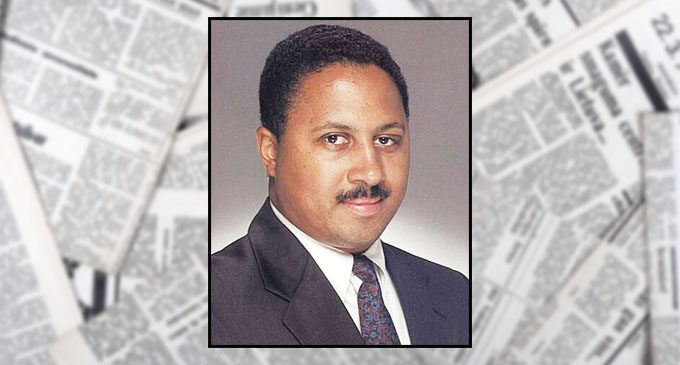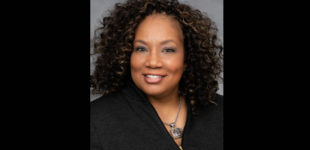Civil Rights Museum chief promises to overcome

BY CASH MICHAELS
FOR THE CHRONICLE
“Sit-in museum owes $933,155 in loan repayment by 2018.”
“Audit reports debt and loss for civil rights museum; director disagrees.”
“Greensboro civil rights museum owes $57K in property taxes.”
Through it all, ICRCM CEO/CFO John L. Swaine has battled back, reminding all of the profound significance of the civil rights museum, the unique place in North Carolina, national and world history that it forever holds, and the tremendous economic and civic contributions it has made to downtown Greensboro and the state since its founding in 1994 by Melvin “Skip” Alston and Earl Jones.
Even the former chief operations officer, Bayard P. Love, in an open letter published locally in March of last year, stated, “In my opinion, the majority of local media coverage regarding ICRCM’s financial position has been unclear, at best.”
“Recent and historic coverage has clearly misled consumers as to the true financial status, challenges and successes of the organization,” Love added.
Owned by the private, nonprofit Sit-in Movement Inc., the museum is listed as the top attraction for visitors to see in Greensboro by the travel website TripAdvisor. As part of the United States Civil Rights Trail, ICRCM has been nominated as a UNESCO World Heritage Site by the National Park Service.
“As we have demonstrated persistence and success up to this crucial stage, against continuing odds, we will remain a dynamic presence in this historic place for the community and as a resource for educators, students, and lifelong learners,” vowed Swaine in a recent 2016 appeal letter to museum supporters.
With a small, but dedicated staff of four full-time and seven part-time employees serving over 70,000 visitors from around the world annually, Swaine says given all of the obstacles the ICRCM has faced, it is committed, in the spirit of the movement, to “overcome.”
That means the museum will continue to boldly represent the proud civil rights legacy sparked by the courage of four African-American N.C. A&T University students – Joseph McNeil, Ezell Blair (Jibreel Khazan), Franklin McCain and David Richmond – who defied segregation laws 57 years ago, when they demanded service at the “whites only” lunch counter of the downtown F. W. Woolworth store –the very site and building where the ICRCM sits now, and where the original lunch counter is still on display.
ICRCM has every intention of grow-ing, and becoming even more of an inter-national symbol of human dignity and justice, Swaine promises.
And yet, those obstacles have been significant.
Swaine says the museum has paid Duke Energy, which now controls the facility’s electricity and gas, over $1.2 million for service through the years, but still squabbles when it comes to making sizable donations to the institution.
It vexes him that other well-known museums across the state are treated much differently by the corporate community, which gives “large amounts of support to some similarly situated museums, and not others.”
Because the ICRCM does not attract the big million dollar contributions like other facilities that do not share its uniqueness, Swaine says he spends most of his time fundraising, writing grants, and cutting costs where possible, all the while developing new programming to keep the museum alive and relevant. Swaine credits “employee and institutional enthusiasm” and commitment for keeping the doors open during tough times.
“How do we take this institution, that really stands for something significant in this town [as] it attracts people from across the world who want to come to Greensboro for the sole purpose of studying human rights and civil rights? If any other city had an organization in its midst that attracted people from across the globe, they would put money there to make sure that it had what it takes to have a proper curatorial department, proper programming every month, have proper monies to operate,” said Swaine.
“This is a challenge for me.”
And it doesn’t help that there has been vocal opposition to the very existence of the ICRCM from politicians.
During a 2015 Greensboro City Council candidates’ forum for mayor and at-large candidates, then-mayoral candidate Devin King, who is black, alarmed many by suggesting that the civil rights museum be moved to the Greensboro Historical Museum, and the F.W. Woolworth building be instead used for commercial purposes.
Referring to the museum, King, who eventually lost his bid, said “there has been nothing but negative from it.”
It also didn’t help when officials in the city administration, including the city manager (who serves on the ICRCM board) and Councilman Mike Barber, among others on the City Council, have also thrown shade on the viability of the civil rights museum. Mayor Nancy Vaughn even raised the prospect of the city taking the museum over.
The council gave ICRCM a $1.5 million forgivable loan in 2013, with the final payment installment now due by February 2018. Yet there has been controversy about the timeliness of the payments.
“I see this place as being singled out, and it’s unfortunate that I have to say it, but it seems like [the ICRCM] is just being shoved to the side in anticipation of a shutdown,” the CEO/CFO says.
“I don’t think they would do this to any other organization,” Swaine said, later adding, “If you are not supporting the culture in your city, then how can you say that you are part of the social fabric?”
Swaine, who joined the museum in 2009 first as a director of finance and administration, acknowledges that in earlier years ICRCM had a turnover in management, and some foundations and corpora-tions still use that as a reason not to generously fund its operations. But as a certified public accountant, he insists that every dollar raised has been accounted for, and proper austerity measures have been put in place to maintain costs at bare minimum, which is why he has been serving both as the Chief Executive Officer and Chief Financial Officer of the museum since 2014.
In fact, Swaine was recognized in 2013 as one of Triad Business Journal’s Financial Executives of the Year when he was just the CFO. Still, it was one of the rare times local Greensboro media has lauded the ICRCM for much.
As indicated before, a large part of the museum’s negative perception problems were because of inaccurate news coverage and inflammatory editorials by local media. Swaine says the major paper in the market has been the source of much of the confusion in recent years, but recently has moderated its stance, even issuing a public apology recently for incorrectly reporting that ICRCM owed “close to $26 million,” which was never true.
Swaine said that all of the museum’s current debts add up to less than $1.3 million.
Indeed last August, the museum retired the $35.6 million in tax credits that funded the rehabilitation of the F.W. Woolworth building by paying off the annual $196,000 debt service.
The ICRCM’s Carolina Bank loan is the biggest part of that $776,000 from a $4 million note in 2009.
Recent local headlines that there are plans to purchase a second building, based on a profitable October, are untrue, Swaine says.
“It’s taken long time to raise a little bit of money to meet short-term obligations,” Swaine says,” and we will be operating very responsibly.”
What is a priority now, besides retiring lingering debt, is getting the ICRCM properly accredited, Swaine says. He also sees stabilizing finances, and attracting sizable endowments as key goals.
For 2017, CEO/CFO Swaine sees increasing fundraising efforts based on having a strong handle on “expected costs” of museum operations.
On Feb. 1, the 57th anniversary of the Woolworth sit-in, the museum is planning a local telethon. Its annual gala is scheduled for Feb. 4, where civil rights veteran Diane Nash, and U.S. Rep. G. K. Butterfield from North Carolina will be honored, among others.
Further staff training and growth are also needed as more exhibits and programs are developed and the civil rights struggles, and new social movements from around the world are explored. An international gallery is also on the drawing board for funding. All of this and more is planned for the “second stage” of the ICRCM’s founding as a national and international museum.
“I want to grow the institution from the ground up,” says Swaine, “and have a firm foundation for every step that we take.”











